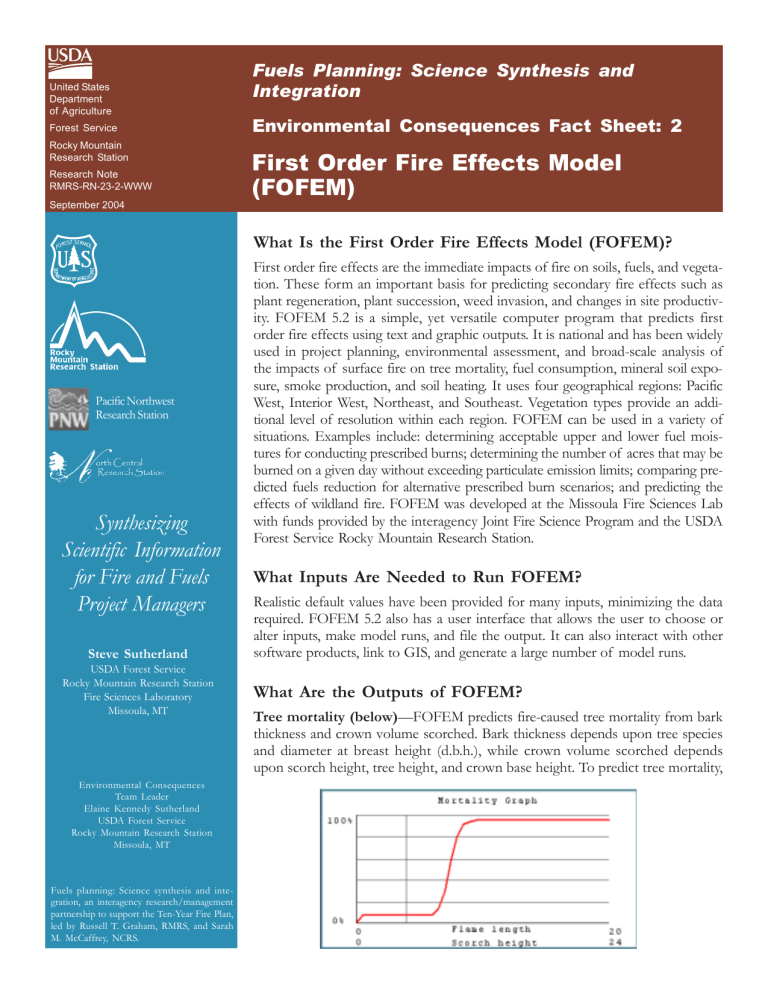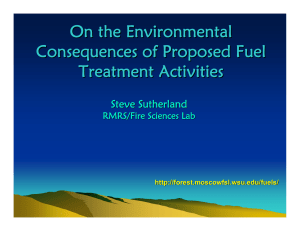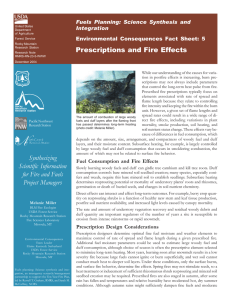First Order Fire Effects Model (FOFEM) Fuels Planning: Science Synthesis and Integration

United States
Department of Agriculture
Forest Service
Rocky Mountain
Research Station
Research Note
RMRS-RN-23-2-WWW
September 2004
Pacific Northwest
Research Station
Synthesizing
Scientific Information for Fire and Fuels
Project Managers
Steve Sutherland
USDA Forest Service
Rocky Mountain Research Station
Fire Sciences Laboratory
Missoula, MT
Fuels Planning: Science Synthesis and
Integration
Environmental Consequences Fact Sheet: 2
First Order Fire Effects Model
(FOFEM)
What Is the First Order Fire Effects Model (FOFEM)?
First order fire effects are the immediate impacts of fire on soils, fuels, and vegetation. These form an important basis for predicting secondary fire effects such as plant regeneration, plant succession, weed invasion, and changes in site productivity. FOFEM 5.2 is a simple, yet versatile computer program that predicts first order fire effects using text and graphic outputs. It is national and has been widely used in project planning, environmental assessment, and broad-scale analysis of the impacts of surface fire on tree mortality, fuel consumption, mineral soil exposure, smoke production, and soil heating. It uses four geographical regions: Pacific
West, Interior West, Northeast, and Southeast. Vegetation types provide an additional level of resolution within each region. FOFEM can be used in a variety of situations. Examples include: determining acceptable upper and lower fuel moistures for conducting prescribed burns; determining the number of acres that may be burned on a given day without exceeding particulate emission limits; comparing predicted fuels reduction for alternative prescribed burn scenarios; and predicting the effects of wildland fire. FOFEM was developed at the Missoula Fire Sciences Lab with funds provided by the interagency Joint Fire Science Program and the USDA
Forest Service Rocky Mountain Research Station.
What Inputs Are Needed to Run FOFEM?
Realistic default values have been provided for many inputs, minimizing the data required. FOFEM 5.2 also has a user interface that allows the user to choose or alter inputs, make model runs, and file the output. It can also interact with other software products, link to GIS, and generate a large number of model runs.
What Are the Outputs of FOFEM?
Tree mortality (below) —FOFEM predicts fire-caused tree mortality from bark thickness and crown volume scorched. Bark thickness depends upon tree species and diameter at breast height (d.b.h.), while crown volume scorched depends upon scorch height, tree height, and crown base height. To predict tree mortality,
Environmental Consequences
Team Leader
Elaine Kennedy Sutherland
USDA Forest Service
Rocky Mountain Research Station
Missoula, MT
Fuels planning: Science synthesis and integration, an interagency research/management partnership to support the Ten-Year Fire Plan, led by Russell T. Graham, RMRS, and Sarah
M. McCaffrey, NCRS.
Fuel consumption (right)—FOFEM predicts fuel consumption for duff, litter, 0–¼ inch, ¼–1 inch, 1–3 inch, >3 inch dead woody fuels (sound and rotten), herbs, shrubs, and canopy fuels affected by crown fire. Mineral soil exposed by litter and duff consumption is also predicted.
Smoke emissions (left)—FOFEM produces a report with separate estimates for flaming and smoldering combustion for each fuel component. These estimates are summed to produce predictions of total emissions for PM2.5, PM10,
CH4, CO, CO2, NOx and SO
2 duration.
, as well as burn
Soil heating (right)—The soil heating model produces graphs of predicted temperature at varying depths and highlights temperatures that exceed 60 degrees Celsius, the lethal temperature for living organisms. The report also includes the maximum temperature reached at the soil surface, amount of duff consumed, soil type, and starting soil moisture.
300
T e m p
( o C)
0
0
Lines represent temperatures at 1 centimeter intervals, starting at soil surface.
100
Minutes users enter a tree list or stand table describing species, diameter, height, crown ratio, and trees per acre.
How Do You Get FOFEM 5.2?
FOFEM 5.0 can be downloaded from: www.fire.org and documentation is included in the help system.
For More Information
Reinhardt, E. 2003. Using FOFEM 5.0 to estimate tree mortality, fuel consumption, smoke production and soil heating from wildland fire.
Reinhardt, E. D.; Keane, R. E.; Brown, J. K. 1997.
First Order Fire Effects Model: FOFEM 4.0, user’s guide. General Technical Report INT-GTR-344.
Environmental Consequences Fact
Sheets
Look for fact sheet topics from the Environmental Consequences
Team including information about the effects of fire behavior and alternative treatment strategies, Wildlife Response Model, weed responses, riparian systems, soil erosion, restoration objectives, treated spaces, the Fire Effects Information System (FEIS), and the First
Order Fire Effects Model (FOFEM).
Fuels Planning: Synthesis and Integration
This fact sheet is one in a series being produced as part of a larger project supported by the USDA Forest Service to synthesize new knowledge and information relevant to fire and fuels management.
Fact sheets address topics related to stand structure, environmental impacts, economics, and human responses to these factors. Information in the fact sheets is targeted for the dry forests of the Inland
West, but is often applicable across broad regions of the country.
For more information, please visit our Web site at: www.fs.fed.us/fire/tech_transfer/synthesis/synthesis_index
The Fuels Planning fact sheets are based on preliminary findings. Information from fact sheets will be synthesized in an upcoming publication.





